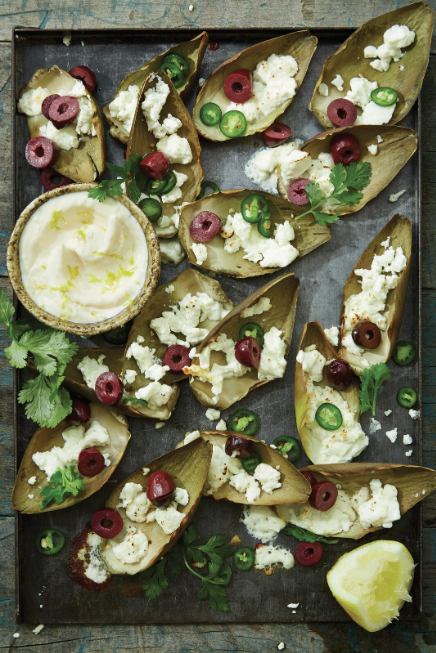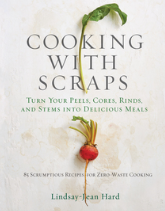Eat these nachos the way you’d eat a regular artichoke leaf dipped in butter—bite the leaf and scrape off the goodness with your teeth. If you’re not worried about potential oxidation of the artichoke leaves, don’t bother coating them in lemon juice—any discoloration will be minor and mainly hidden by the toppings. However, you might want to consider coating the hearts and stems with lemon juice to keep them at their prettiest.

Servings: Makes a sheet-pan’s worth
Ingredients:
4 medium-size artichokes
1 small garlic clove
Fine-grain sea salt
1⁄3 cup mayonnaise
1 tablespoon freshly squeezed lemon juice
Pinch of granulated sugar, to taste (optional)
2 ounces feta cheese, crumbled (about 1/2cup)
2 to 3 ounces sliced black or kalamata olives (1⁄3 to 1/2 cup)
Freshly ground black pepper (optional)
1/2 serrano pepper, sliced (optional)
2 tablespoons coarsely chopped cilantro leaves, for garnish (optional)
Instructions:
Bring a large pot of water to a boil and preheat the oven to 375°F.
While the water comes to a boil, remove all of the tough outer green leaves from the artichokes. These will be your nachos. Don’t rush through this task (you’ll risk ripping off the tender, tasty parts at the bottom of the leaves), but don’t take the time to sort through them at this point. Stop once you get to the leaves that are directly above the heart, the ones that are a little lighter in color and floppier—they aren’t sturdy enough for nachos. (It goes without saying to save the artichoke stems and hearts for another purpose, right? Good.)
Add the artichoke leaves to the boiling water and cook until the ends are tender, 8 to 10 minutes. Test one to make sure and then drain them in a colander.
While the artichoke leaves are cooking, make the cheater’s aioli: With the side of a knife, smash the garlic clove. Sprinkle it with a pinch of sea salt. Alternate chopping and smashing it again with the side of the knife until it turns into garlic paste. Transfer the paste to a small bowl. Whisk in the mayonnaise and lemon juice. Now taste it! This is important, since mayos are different. If you used a more vinegary one, you might need a pinch of sugar to round it out, or if it needs a little more tang, add a touch more lemon juice.
Line a sheet pan with parchment paper (optional, but makes for easier cleanup), and place the artichoke leaves on the pan in a single layer, insides facing up, so they’re cup-shaped, ready to hold toppings. Sort through the leaves as you place them, discarding any particularly gnarly-looking ones, or any missing their tender tasty ends.
Sprinkle the feta and black olives across the leaves and bake just long enough to heat everything through, letting the feta get soft and a little slumpy, 8 to 10 minutes.
Remove from the oven, dollop with the cheater’s aioli, and top with black pepper, serrano slices, and cilantro, if desired. Eat, preferably directly from the pan.
More about Cooking With Scraps:
 “A whole new way to celebrate ingredients that have long been wasted. Lindsay-Jean is a master of efficiency and we’re inspired to follow her lead!”
“A whole new way to celebrate ingredients that have long been wasted. Lindsay-Jean is a master of efficiency and we’re inspired to follow her lead!”
—Amanda Hesser and Merrill Stubbs, cofounders of Food52
In 85 innovative recipes, Lindsay-Jean Hard—who writes the “Cooking with Scraps” column for Food52—shows just how delicious and surprising the all-too-often-discarded parts of food can be, transforming what might be considered trash into culinary treasure.
Here’s how to put those seeds, stems, tops, rinds to good use for more delicious (and more frugal) cooking: Carrot greens—bright, fresh, and packed with flavor—make a zesty pesto. Water from canned beans behaves just like egg whites, perfect for vegan mayonnaise that even non-vegans will love. And serve broccoli stems olive-oil poached on lemony ricotta toast. It’s pure food genius, all the while critically reducing waste one dish at a time.
“I love this book because the recipes matter…show[ing] us how to utilize the whole plant, to the betterment of our palate, our pocketbook, and our place.” —Eugenia Bone, author of The Kitchen Ecosystem
“Packed with smart, approachable recipes for beautiful food made with ingredients that you used to throw in the compost bin!” —Cara Mangini, author of The Vegetable Butcher
Buy the Book
Amazon | B&N | Indiebound | Workman





No Comments